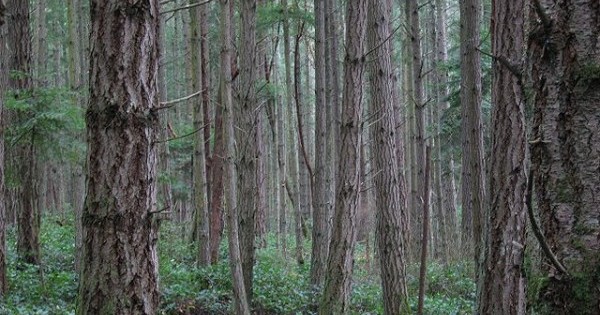
My first night, it’s dark. No streetlamp, no starlight, no moonlight. I can’t see my own hand. I can’t see my feet on the ground. I feel my way along a crunching graveled path into the woods toward my cottage. My flashlight does not seem to be working. I am in residence at Hedgebrook, a retreat for writers on Useless Bay on Whidbey Island on Puget Sound, State of Washington.
I reach my very own (for the week) cottage, enter, light the fire in the wood stove, and consider the silence—the sound of wind tossing the tops of tall trees. Later, asleep in the loft, I half-dream an eerie wail that begins coyote and resolves as a sort of rooster. This, I’m told the next day, is the call of a barred owl.
The woods on Whidbey Island are your basic Pacific Northwest conifer forest. Douglas-fir trees as tall as telephone poles, punctuated by western red cedar, noble fir, western hemlock, and red alder—graceful birchlike trees with trunks coated with white lichen. The understory is salal, Oregon grape, sword ferns, and moss.
I am, by choice, an urban, indoor type. But I grew up in this kind of silence (well, not this kind, but another kind), and it feels like home.
The next day I take a walk back into the woods, the path lumpy with roots and fallen logs thick with moss. A bird (a duck?) startles up from a small pond coated with green scum, which I take to be green algae. The cones of Doug-firs—oval-shaped with flat three-pronged bracts sticking up between the scales—lie everywhere on the ground. As do alder catkins. No cement here. None.
I’m in the woods but not roughing it. Every evening, after a day of writing, the writers gather at the farmhouse for a convivial dinner. The cooks are master chefs posing as competent, warm, and, dare I say, motherly, providers. Dinner is organic, much of it grown in the huge garden, and it was picked or killed that day. It is beyond delicious. We writers are all women and forbidden to wash a dish. After dinner we gather in the farmhouse living room to share work before returning to our cottages.
Nature is everywhere, so why go to the woods? It’s crawling in the sewer, weedy in the lot, loud as gulls above the streets of downtown Seattle. It’s on the pavement, in the road, in our house, microbial in our nose. We are part of nature, and nature is right here.
But in the woods I become hyperaware of life—birds, bugs, chipmunks, ravens. My heart rate drops. I begin to comprehend the cosmic extent of my ignorance. What exactly is that bald eagle doing, perched on a high tree across the road, unmoving as if taxidermed to the branch. What is the name of that graceful, leafless (in March) bush with long stems tipped with white somethings? (Buds? Beginning berries?) What is making that cheeping noise?
We know the facts. We know that we are in the midst of Earth’s sixth great mass extinction. We learn that “seven out of ten biologists believe that this dramatic loss of species poses a major threat to human existence in the next century,” according to the American Museum of Natural History’s Hall of Biodiversity. Our loss of some 30,000 species each year (according to biologist E. O. Wilson) has not impressed the public overly much. The causes: harvesting to excess, habitat degradation, invasive species often imported as inadvertent cargo, and global warming.
Here in the woods, something shifts. I’m typically goal oriented—some would say goal obsessed. But today I’m struck by this unoriginal thought: my life is one component in a flow of life-energies interconnected and never ending and never completely understood. For this moment at least, I get a sense of what it is we are losing and will keep on losing—unless we can contrive to save it. And this is a good reason to go into the woods.

